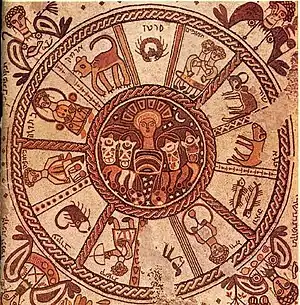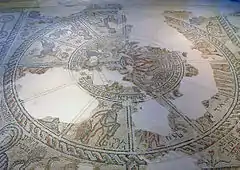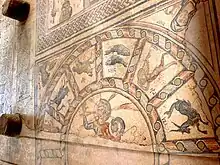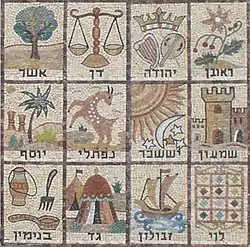






Synagogues from Israel of the 4th-6th centuries CE had three-panel mosaic floors, the center panel of which contained the Jewish zodiac.[1]
Background
Four or more examples were found in Israel. Some of the buildings' art was remarkably well-preserved, giving a window into the specifics of partially-lost traditions. The craftsmanship of these as well as of other unexpected historical Jewish art has been previously called "touchingly naive," "untutored," and even "primitive," but these critical dismissals are now[2] outdated.
They were found in Beth Alpha and Hammat-Tiberias[3] near the Sea of Galilee, Na'aran, in the Jordan Valley, and Avi-Yonah in the Golan Heights.[4] In 1993, the most elaborate mosaic yet was found in Sepphoris. It has some uniques: scenes of the accessories and sacrifices of the Temple and a scene of the angels visiting Abraham and Sarah. "Elegant indeed... we find Scorpio (עקרב) together with its Hebrew month Heshvan (חשון), Sagittarius (קשת) together with Kislev (כסלו)".[3]
The format is quite rigid. Hachlili[5] says Jewish communities "always used the same scheme for their floors." There are four figures (seasons; cf eg Sparta winds) on the outer corners. Within is a roundel with twelve depictions. In the bullseye is a sun god with the appropriate horses-chariots imagery. Jodi Magness argues the sun god is Helios and to be identified with Metatron. [6]
The Beth Alpha example has been called one of Israel's great artistic treasures,[7]
so filled with feeling and so packed with information for scholars to study. It revolutionized ideas about ancient Jewish attitudes toward representational art, which many previously believed had been nonexistent.
One more[8] was found in Greece.
See also
External
- Possibly the highest-quality version generally available of the header image may be found at http://www.catacombsociety.org/odyssey-sotterranea-a-search-for-shared-universal-symbols/
- Rarer sort of all-in-one photo of Sippori synagogue https://smarthistory.org/wp-content/uploads/2022/07/Orthophoto-of-the-Sepphoris-Synagogue-Please-note-that-the-lights-appearing-on-the.jpg
- Photos https://commons.wikimedia.org/wiki/Category:Mosaic_in_Maon_synagogue
Bibliography
- An overview mentioning all four. Hachlili, Rachel (1977). "The Zodiac in Ancient Jewish Art: Representation and Significance". Bulletin of the American Schools of Oriental Research. American Schools of Oriental Research (228): 61–77. ISSN 0003-097X. JSTOR 1356500. Retrieved 2023-11-04.
- Magness, Jodi (2005). "Heaven on Earth: Helios and the Zodiac Cycle in Ancient Palestinian Synagogues". Dumbarton Oaks Papers. Dumbarton Oaks, Trustees for Harvard University. 59: 1–52. ISSN 0070-7546. JSTOR 4128749. Retrieved 2023-11-04.
References
- ↑ Hachlili 1977, pp. 61.
- ↑ Chakovskaya, Lidia (2021-01-01). "The Artistic Milieu of the Mosaic of the Beth Alpha Synagogue". The Synagogue in Ancient Palestine: Current Issues and Emerging Trends. Eds.Rick Bonnie/ Raimo Hakola/ Ulla Tervahauta. Retrieved 2023-11-04.
- 1 2 "Jewish Worship, Pagan Symbols". Biblical Archaeology Society. 2023-07-16. Retrieved 2023-11-04.
- ↑ Note:Previously the Kfar Bar'am relief was claimed to be zodiac. There is difference over the status of the mosaic floor at Yahpia. Editor, Temerarius, restating Hachlili.
- ↑ Hachlili 1977, pp. 61–77.
- ↑ Magness 2005, pp. 1–52.
- ↑ "Bet Alpha Synagogue". Frommer's. Retrieved 2023-11-04.
- ↑ VARIA The Four Seasons in Zodiac Mosaics: The Tallaras Baths in Astypalaea, Greece* Ruth Jacoby Centre for Jewish Art, The Hebrew University of Jerusalem